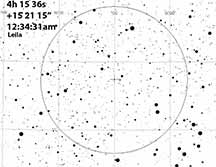
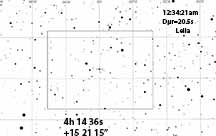
This event has a big challenge - there's a much brighter event on a bright 8.7 magnitude star just 3 minutes before this one, by 2001 QD35. It will take very fast accurate GoTo and field ID to succeed in getting this one. This event is 20.5s long, and we're inside the path and the odds of a 'hit' are high. However, the star astrometry has an RUWE of 1.65; bigger than the 1.2 limit where the star position is more questionable. The event being 20s long, drop=2.3 mag so ideally we'd want 3.2 minutes before the event (10x diameter) to see if there were any moonlets. But the bright 8.7 mag event just before will prevent that, and we'll just have to get what we can get here
Alt=31, Az=265 in Taurus, just below the point in the "V" of the Hyades
 |
 |
I was able to swing successfully to the target and get it on-chip in time. However, I did not have the time to take out the gear slop and get it tracking perfectly. That ended up costing time at the end of the event, as drift almost caused the star to leave the usable area of the chip only 1 minute after the event was done. However, I still did get good data at 4x, from the cul-de-sac of Pine Ridge Rd in Bonny Doon. Nice spot for future reference, Very unobstructed skies, no hassles. After the bright 2001QD35 8th mag occultation 3 min prior, I got on and recording for this event soon enough to get it, but only by about 30s prior to expected event. . The D and R both looked on the monitor, live, distinctly like steps, of about .5 magnitudes or so, by eye. Not reduced or downloaded as I write this.
Long: 122 07 06.35"
Lat: 37 02 35.49
Elev 527m
Begin: 08:34:09 UT, End: 08:35:14 UT. I could not get the long duration I'd hoped for and that this event deserved, due to poor tracking and drift. I had to end the recording early as the target approached the numerals of the VTI.
After reductions: In fact, the steps are not there. Although the R has a strange wiggle to it, but within errors it's not evidence of a step, not apparently the signature of a binary star.
magDrop report: percentDrop: 86.7 magDrop: 2.191 +/- 0.112 (0.95 ci)
DNR: 3.79
D time: [08:34:27.1804]
D: 0.6800 containment intervals: {+/- 0.0162} seconds
D: 0.9500 containment intervals: {+/- 0.0410} seconds
D: 0.9973 containment intervals: {+/- 0.0785} seconds
R time: [08:34:42.2864]
R: 0.6800 containment intervals: {+/- 0.0162} seconds
R: 0.9500 containment intervals: {+/- 0.0410} seconds
R: 0.9973 containment intervals: {+/- 0.0785} seconds
Duration (R - D): 15.1060 seconds
Duration: 0.6800 containment intervals: {+/- 0.0239} seconds
Duration: 0.9500 containment intervals: {+/- 0.0533} seconds
Duration: 0.9973 containment intervals: {+/- 0.0949} seconds
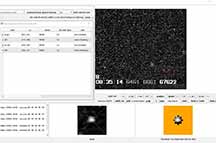 |
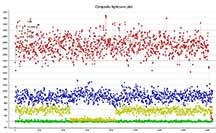 |
 |
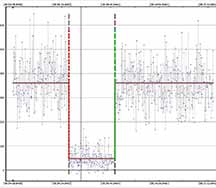 |
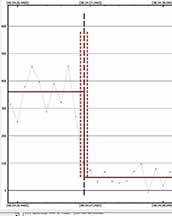 |
|
After the full return to brightness at the R, there's a curious dip which has no analog at the D, and so is hard to interpret. Perhaps just noise. |
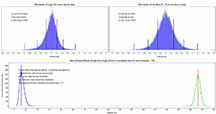 |
report filed with IOTA on 2/1/25. Karl's data not yet reported.
Kirk did not succeed in getting on target in time. With only a 2 minute gap between events, it is not to be assumed that one can succeed at such a rapid get-on-target. So, I'll log this as a purple heart (wounded in battle) valiant attempt.
Got good data, he believes. Saw the occultation as about 5s or so, so must have been pretty close to the edge of the path. He might even have only one of the two stars occulting, if we look closely? That's just a wild thought at this moment. Clear evidence of either cloud wisps or jitter in the pointing, at several places in the record. No convincing dips due to possible moonlets that are probable enough to give credibility to. RN's record doesn't extend before the event very far but also doesn't show any credible moonlet events.
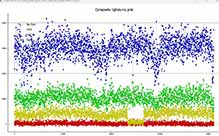 |
 |
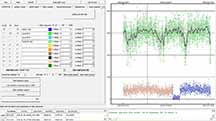 |
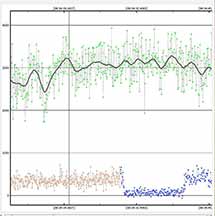 |
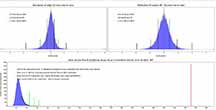 |